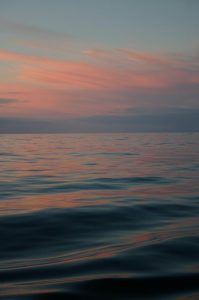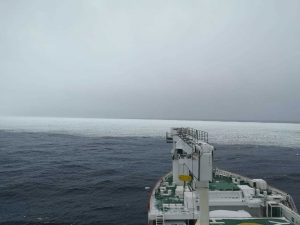On World Oceans Day we celebrate the research done in the Southern Ocean within the South African National Antarctic Program(SANAP). South Africa has a comparative geographic advantage for conducting research in Antarctica and the Southern Ocean. It is the closest African nation to the Austral Polar region, separated from the continent of Antarctica by approximately 4000 km of Open Ocean that contains a regionally unique configuration of ocean circulation, making the region key to understanding past, present and future evolution of global climate.
This distance is the greatest of all southern continents to the Antarctic continent, but most significantly it allows for a regionally unique configuration of ocean circulation to occur.
 A line from Cape Town to the Prince Edward Islands and beyond transects this dynamic region where ecosystem shifts are commuted from the tropics to the temperate gyres of the South Atlantic via the Agulhas current and its leakage. It is also the region where nutrient-rich polar waters of Antarctic Circumpolar Current converge;
A line from Cape Town to the Prince Edward Islands and beyond transects this dynamic region where ecosystem shifts are commuted from the tropics to the temperate gyres of the South Atlantic via the Agulhas current and its leakage. It is also the region where nutrient-rich polar waters of Antarctic Circumpolar Current converge;- The Atlantic–South West Indian Ocean sector of the Southern Ocean encompasses some of the strongest pathways for CO2 exchange and storage. South Africa already partially capitalizes on its geographical advantage through established long-term observations programmes, including the atmospheric green-house gas observations at Cape Point;
- The Southern Ocean is globally significant as it represents a region where polar marine living resources surpass that of all other oceans;
- The Southern Ocean marks the intersection of the most important sources of deep and bottom water, which modulate both the heat and CO2 exchange with the atmosphere, and their storage in the ocean. (Figure above: The Southern Hemisphere showing major land-masses and ocean currents (Rintoul , S.R., C. Hughes, and D. Olbers. (2001).climate.)



 Collection of images contributed to ALSA archive by Adriaan Dreyer of sunrises and sunsets over the ocean during the 2009 Takeover Voyage on the S.A. Agulhas II
Collection of images contributed to ALSA archive by Adriaan Dreyer of sunrises and sunsets over the ocean during the 2009 Takeover Voyage on the S.A. Agulhas II
The Social Media Campaign for World Oceans Day is “Together We Can #ProtectOurHome”. For 2020 World Oceans Day is uniting conservation action to grow the global movement calling on world leaders to protect 30% of our blue planet by 2030. This critical need is called 30×30. By safeguarding at least 30% of our ocean through a network of highly protected areas we can help ensure a healthy home for all!

 Another collection contributed to the ALSA archive is by Mardene de Villiers taken during the Scale cruise of 2019
Another collection contributed to the ALSA archive is by Mardene de Villiers taken during the Scale cruise of 2019
 The Earth Systems research theme within SANAP investigate the Southern Ocean in the Coupled Ocean – Atmosphere, Climate and Earth System and Large Scale Ocean Circulation and Global Climate. (The South African Antarctic and Southern Ocean Research Plan 2014 – 2024) These themes are covered with the following research projects in the current SANAP research cycle:
The Earth Systems research theme within SANAP investigate the Southern Ocean in the Coupled Ocean – Atmosphere, Climate and Earth System and Large Scale Ocean Circulation and Global Climate. (The South African Antarctic and Southern Ocean Research Plan 2014 – 2024) These themes are covered with the following research projects in the current SANAP research cycle:
- How storm characteristics in the Southern Ocean influence inter annual variability of CO2 fluxes by Dr Pedro Monteiro from CSIR.
- Seasonal evolution of biogeochemical Fe cycle in the Southern Ocean by Dr Thato Nicholas Mtshali from CSIR .
- The role of storms in shaping upper ocean physics and primary production in the Southern Ocean by Dr Sarah-Anne Nicholson from CSIR .
- An improved understanding of the climate sensitivity of the Southern Ocean’s biological carbon pump by Dr Sandy Thomalla from CSIR .
- Bottom-up and top-down control of seabirds of the Southern Ocean: implications for conservation by Dr Azwianewi Benedict Makhado from DEFF.
- Southern Indian Ocean Top Predators: linking ecology, oceanography and marine spatial planning needs by Dr Pierre Pistorius from Nelson Mandela University.
- Shifts in phytoplankton and microbial community composition and functional diversity related to trace metal cycling in the Southern Ocean by Dr Susanne Fietz from Stellenbosch University.
- Distribution and Speciation of Bioactive Trace Elements in Southern Ocean by Prof Alakendra Roychoudhury from Stellenbosch University.
- Biogeochemical controls on the sources and chemical composition of Southern Ocean marine aerosols by Dr Katye Altieri from University of Cape Town.
- SAMOC-SA by Prof Isabelle Ansorge from University of Cape Town.
- A nitrogen cycle view of atmospheric CO2 sequestration in the Antarctic Ocean by Dr Sarah Fawcett from University of Cape Town.
- Southern Ocean influences on Western Cape Drought and Flood Events by Prof Chris Reason from University of Cape Town.
See article during 21 journey of Covid-19 featuring our oceans

